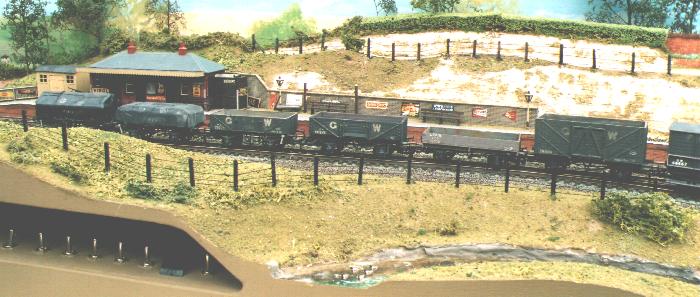 |
A "cut" of open wagons pause during shunting operations at Upper Isis.
indent Many period modellers do not have enough open wagons on their models, which is a shame because until WWII they outnumbered vans by roughly 10 to 1! I suspect the reason is that a van looks the same empty or loaded and so can be run in and out without looking silly whereas open wagons need a load in at least one direction if they are not to spoil the illusion. Opens also came in a far wider variety of shapes and sizes, as did their loads. Here are a few typical, if mainly GWR, "opens"...
indent Running through the above from left to right; on the left is an "Open A" with the bar raised to support a wagon sheet*. (*See below.) Next to it are 2 more "Opens" without sheet rails, one with a wagon sheet and one without. All three are Great Western wagon kits by "Coopercraft" with a 9 foot wheelbase. In the 1920s the wheelbase was lengthened to 10' to comply with a new RCH specification and the GWR's response was a slightly longer wagon, this time with the familiar long brake handle rather than the peculiar Dean/Churchward brake of earlier wagons. This next wagon is an old Airfix model but similar are currently available commercially. Next comes an LMS 3-plank (a kit but I forget whose it was!), and finally another Coopercraft, this time of the rare but interesting "Provender Wagon" built especially to move hay to Swindon for the shunting horses! (Again, all these models are of specific Diagram numbers and are reasonably easily identified with the right reference books.)
indent These opens are an excellent
illustration of the most common type of wagon to be found at any British station between
the wars. This is because the "open" wagon was cheaper to make than a box
van and it was common to keep the rain out of susceptible loads with a "wagon
sheet" until the labour involved in tying them on and taking them off finally became
a factor in the accountant's figures. At the turn of the 19th century open wagons
formed 90% of the wagon stock. This gradually fell but it was not until BR days that
the van became more common than the open - although to look at many people's model
railways you could be forgiven for not realising the fact!
indent Of course the reason is
simple, even for those who know what the proper ratio should be; the box van looks the
same empty or loaded and so the imagination can be brought into play. Of course the
same can be said for the tarpaulin because it could be almost anything underneath,
particularly when considering the GWR "open A" which had a hinged bar which
could be raised to hold the wagon sheet up like a roof. When a wagon sheet was
allowed to lie flat or droop between the wagon sides, any pin-prick holes let water
through and this had always been a nagging problem for the long-suffering merchant sending
his goods by rail. Unfortunately, the GWR was the only company to adopt the raised
rail idea as a standard but at least the post-group "wagon pooling" means a GW
"open A" can turn up on almost any post mid 20s layout! With an excellent
plastic kit available on which any "I can't do that!" lettering can be obscured
by the wagon sheet, so there really is no excuse for not getting this right; your model
railway will look all the better for it!
| Previous photograph in series | Back to "Upper Isis Room" entrance | Next photograph in series |